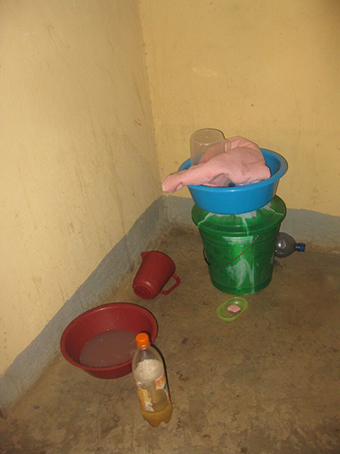13.3.1 Economic factors influence WASH practices
The cost of constructing a protected water source, a latrine or handwashing facilities may be too much for some households to pay, especially when purchasing WASH facilities and services is seen as a lower priority than spending limited financial resources on other needs. Primary priorities for most households, whether urban or rural, include secure housing, food, clothing and education for their children, and possibly also transport costs to take children to school or adults to work. Installing even the most basic latrine or handwashing basin may be unaffordable, but people can still wash their hands with a bowl and a bar of soap (Figure 13.7).

However, constructing a latrine is much more expensive than buying a plastic bucket and some soap. The typical cost of a circular concrete slab for a pit latrine was about 260 ETB in 2015, plus there is also the cost of digging the pit and constructing a shelter, and paying a carpenter or bricklayer.
Local government may be able to assist households to obtain loans at low interest rates so that they can install WASH facilities. Community WASH projects may also be funded by local contributions and provide shared labour to build a communal latrine or protect a water source from contamination by human and animal waste.
Although there are costs involved, installing a WASH facility can also save some expenses for a household that uses them consistently. Diarrhoea, worm infestations and other communicable diseases resulting from poor WASH practices cause a significant economic burden on individuals, families, communities and Ethiopia nationally.
Can you think of expenses that the family of a child with severe diarrhoea will have to pay?
You may have mentioned the cost of treatment, including transport costs if the child goes to the health centre; and family members may lose income from their employment while caring for the sick child.
These expenses could have been reduced by using a latrine, handwashing at critical times and accessing improved water sources. The prevalence of diarrhoea among children in Ethiopia is still high: it tops the list of causes of morbidity (illness) in children under 5 and accounts for 16.5% of cases (MoH, 2014). If you multiply the costs to a single family with a sick child by the huge number of illness episodes that could be prevented by good WASH practices, you can see that WASH could bring huge economic benefits to the nation.
13.3 Other influences on WASH practices
